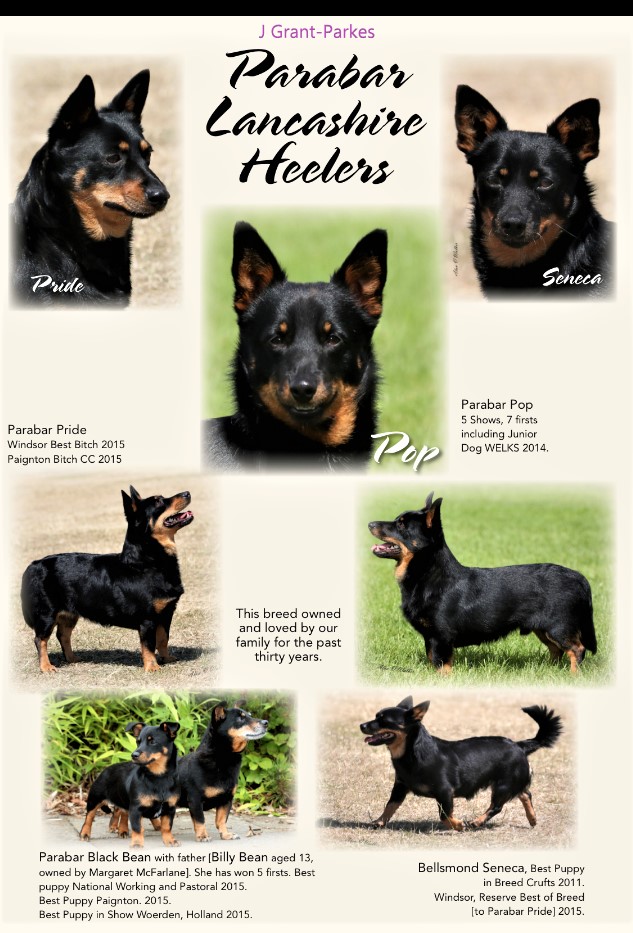About Lancashire Heelers
Native to the UK, Lancashire Heelers belong to the Pastoral Group of dogs, being the smallest of them they were the drover’s dog. Small, intelligent and agile enough to duck and dive and avoid the animals kick.
Their ancestry, as with many breeds, lies in the mists of time but are thought to have originated in the Ormskirk area of Lancashire. Coming in two colours, black and tan being the most popular historically. The liver and tan is also a recognised colour, being a recessive gene which is inherited from the black and tan parents. Liver and tan was not a colour that farmers liked as they can’t be seen in the half light of dawn and dusk, particularly when standing still! Often mistaken for a fox, given away or destroyed and not recognised in the breed until much later.
The Lancashire Heelers were used to drove cattle and sheep etc. long distances to and from markets, docks etc. Their decline came when trains and then lorries could transport livestock much faster. Today, they are rarely used for this purpose and are largely bred as pets with the good ability to be used for tracking, cani-cross, agility and flyball.
Attractive, intelligent, faithful, friendly and full of life, Lancashire Heelers make wonderful companions. “They’re also a very determined herding breed, with terrier-like instincts”. They are healthy, energetic and easy to look after, a good solid British breed.
About Parabar
Being raised on a stud farm, Jenny Grant-Parkes has always been surrounded by animals. The Twylands Stud was formed in 1958 (following a near fatal riding accident after her mother’s, Barbara, hunter Smoky Joe crushed her in a fall) she and Jenny bred and showed the ponies of the famous Twylands stud, winning Supreme Champion at The Royal Show in 1966 and winning Horse of The Year Show with the riding ponies more than once in the following years, having to qualify the ponies at other qualifier shows during the previous show season to be eligible to enter The Horse of The Year Show (the stud farm was disbanded in 2006 due to her mother’s ill health.)
The beef cattle and sheep on the farm were never shown, their quality was always commented on by the auctioneers and the top prices regularly achieved.
From 2000 Jenny decided to show her Wiltshire Horn Sheep, becoming the most successful exhibitor three years in succession and holding the highest price achieved for her Supreme Champion Ram to date.
The family has owned Great Danes since 1928, with the Parabar Great Danes, Rottweilers, Chihuahuas and Minpin dogs being shown by Jenny’s mother and then herself during her childhood and teens. When Jenny married and had her own children, she wanted a small intelligent family dog, because the German Shepherds and other large dogs were too big, especially when loading adults, children and their school friends into the car, so we acquired our first Lancashire Heeler puppy over 30 years ago and the rest as they say is history.
Her mother Barbara started showing dogs in the 1950s until the late 1980s until her health would not allow and Jenny’s family were taking all her spare time, so decided dog showing was going to have to stop.
Having never intended to show these charming dogs, Jenny just wanted a pet, but breeding and showing must be in the blood because in 2001 when, due to the Foot and Mouth crisis, she couldn’t show the sheep, so she asked if she could enter the dog instead. Yes, Parabar Pippin won First and Best Puppy in Show! Parabar Peat did the same in 2007. Ever since Jenny has annually qualified different dogs at qualifying shows for Crufts, winning Best Puppy In Breed on more than one occasion, Reserve Best of Breed on several occasions and numerous First prizes.
When other peoples’ Lancashire Heelers are entered and win prizes at shows very often are other Parabars or carry Parabar breeding amongst them to keep the Parabar flag flying, highlighting and raising awareness of this vulnerable native breed. She seems to have inherited the family eye for good stock, as Parabars are now inhabiting other countries including Australia, Belgium, Czechoslovakia, Denmark, France, Finland, Holland and Switzerland amongst others.
At events where Jenny is not showing a dog, she can often be found with the public. Such as The Three Counties Autumn Show, ‘World of Animals’ exhibit area, with several friends and heelers, so the public can have ‘hands-on’ experience whilst raising awareness and answering any questions about this wonderful little breed of dog. It is also a great way to show people, who may not know about Lancashire Heelers, what the breed is all about. Not being a professional breeder, but an enthusiastic hobbyist who is passionate about the breed, Jenny does this because the breed needs highlighting and without the support of people like Jenny, the breed could decline to the point of no return, (an average of only 100 puppies are registered with the Kennel Club each year) such has happened to the Talbot dog, which is now only seen on pub signs.
About Parabar and Kennel Club
All Parabar puppies are litter screened under 12 weeks and DNA tested for PLL (Primary Lens Luxation) and CEA (Collie Eye Anomaly) in line with the Lancashire Heeler Association Breed Club and Kennel Club rules and recommendations. Micro chipped and Kennel Club registered, adults are also patella or stifle scored when they are over 12 months of age, if they are kept for breeding.
PLL is a very painful glaucoma-like disease, if not tested for it will mean a dog can go blind. CEA is also a disease that is potentially blinding, although not painful a dog may not see a car coming or could fall off a cliff on a walk! These are not old age diseases like a cataract.
None of my dogs are affected by the above.
